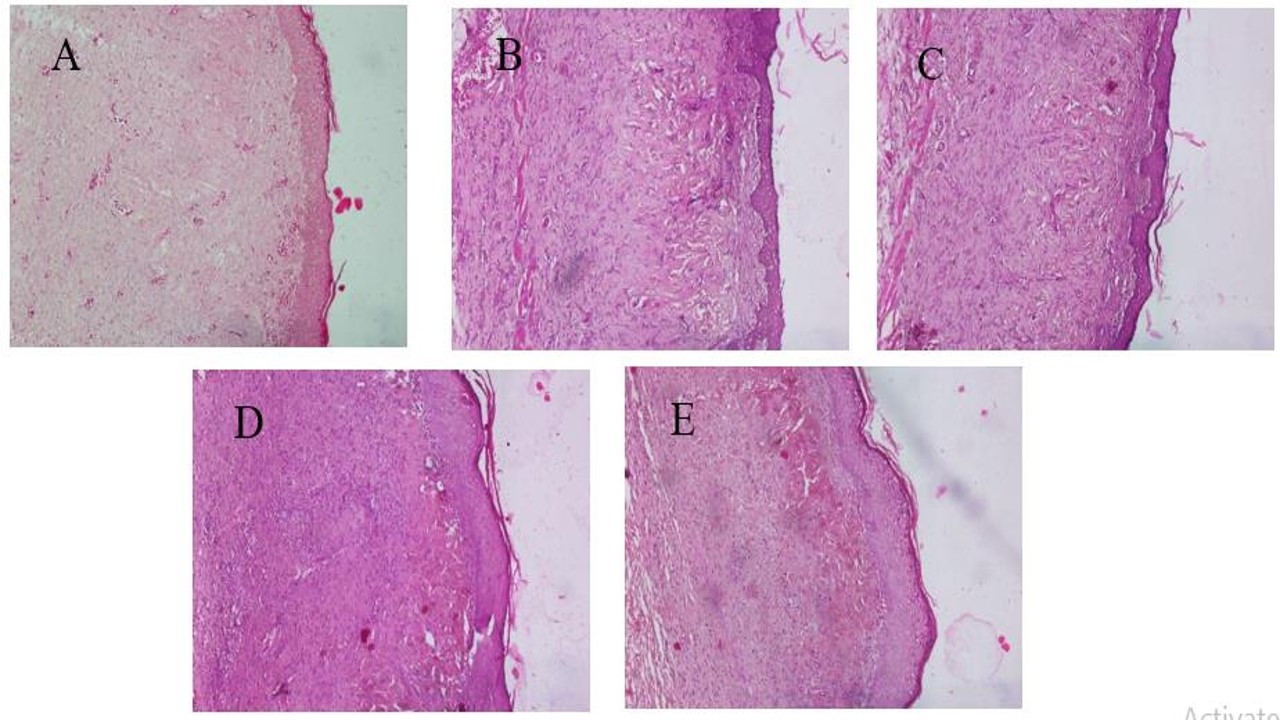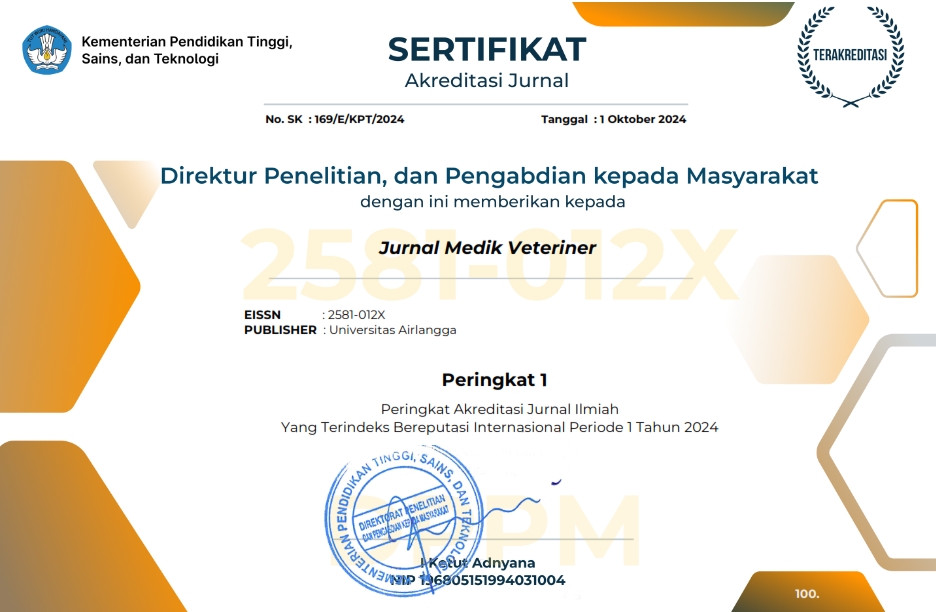Efficacy of Transdermal Delivery Nano Ethosomal Gel from Ashitaba Leaves on In-vivo Burn Wound Healing in Albino Rats

Downloads
This study aimed to evaluate the in-vivo burn wound healing process in albino rats treated using transdermal delivery nano ethosomal gel from ashitaba leaves. Ethosomal vesicles were formulated using soy lecithin, cholesterol, ethanol, water, and ashitaba leaf nanoparticles using the cold method. A total of 25 male rats were randomly divided into 5 groups, i.e., (C-) treated without nanoparticle extract, (C+) treated using 1% Silver Sulfadiazine®, treatment group treated nano ethosomal gel from ashitaba leaves with the respective doses were (T1) 1%, (T2) 2,5%, and (T3) 5%. Therapy was initiated on day 1 or after being induced by a burn wound for 14 days, twice a day. On the 15th day, a termination was carried out to take skin tissue from burn scars, then histopathology preparations were made with routine staining. Microscopic observations with an optical microscope on collagen, polymorphonuclear cell infiltration, angiogenesis, and re-epithelialization. The T3 group that was treated using 5% nano ethosomal gel showed the best burn wound healing, this may be caused by compounds in ashitaba leaf nanoparticles which have antioxidant, anti-inflammatory, and antibacterial effects, thus the use of transdermal delivery therapy of 5% ashitaba leaf nano ethosomal gel was effective for wound treatment burn on rat skin.
Abdeldjelil, M. C., Messai, A., Boudebza, A., & Beghoul, S. (2017). Practical aspects to generate cutaneous experimental burns in a rat model. Dermatology Pharmacia Letter, 9(1), 70–84.
Akbari, H., Fatemi, M. J., Iranpour, M., Khodarahmi, A., Baghaee, M., Pedram, M. S., Saleh, S., & Araghi, S. (2015). The healing effect of nettle extract on second degree burn wounds. World Journal Plastic Surgery, 4(1), 23–28.
Al-Anshori, A. A., Retanti, D. A., Trilestari, I., Maslachah, L., & Plumeriastuti, H. (2019). Nano spray inhaler ashitaba leaf extract (Angelica keiskei) on malondialdehyde, catalase enzyme activity and lung tissue damage in mice exposed to cigarette smoke. Indian Veterinary Journal, 96(11), 58–61.
Barry, B. W. (2001). Is transdermal drug delivery research still important today? Drug Discov Today, 6, 967–71.
Bendas, E. R., & Tadros, M. I. (2007). Enhanced transdermal delivery of salbutamol sulfate via ethosomes. AAPS Pharmacy Science Technology, 8(4), E107.
Berrak, B. C., & Yegen, C. (2004). Systemic responses to burn injury. Turkish Journal Medical Science, 34, 215–226.
Bhatia, N., Arunpreet, S., Rohit, S., Amandeep, S., Varinder, S., Gurjeet, S., Jaideep, B., Ravi, D., & Balwinder, S. (2014). Evaluation of burn wound healing potential of aqueous extract of Morus alba based cream in rats. Journal Phytopharmacology, 3(6), 378–383.
Caesar, L. K., & Cech, N. B. (2016). A Review of the Medicinal Uses and Pharmacology of Ashitaba. Planta Medica, 82(14), 1236–45.
Cai, E. Z., Ang, C. H., Raju, A., Tan, K. B., Hing, E. C. H., Loo, Y., Wong, Y. C., Lee, H., Lim, J., Moochhala, S. M., Hauser, C. A., & Lim, T. C. (2014). Creation of consistent burn wounds: A rat model. Archives of Plastic Surgery, 41(4), 317–324.
Hamid, I. S., Aksono, E. B., Sukmanadi, M., & Purnama, M. T. E. (2018). Antiangiogenesis activity test of tin leaf (Ficus carica L.) on the number of blood vessels and VEGF expression of chorioallantoic membrane of embryonated chicken eggs. European Journal of Oncology Pharmacy, 1(4), e00007.
Hamid, I. S., Ekowati, J., & Purnama, M. T. E. (2019). Kaempferia galanga L. Inhibiting Effect on Vascular Endothelial Growth Factor (VEGF) and Cyclooxygenase-2 (Cox-2) Expression on Endothelium of Chorioallantoic Membrane. Indian Veterinary Journal, 96(9), 80–82.
Iizhar, S. A., Syed, I. A., Satar, R., & Ansari, S. A. (2016). In vitro assessment of pharmaceutical potential of ethosomes entrapped with terbinafine hydrochloride. Journal of Advanced Research, 7(3), 453–461.
Jain, N. K. (2001). Advances in Controlled and Novel Drug Delivery. 1st ed. New Delhi: CBS Publication, p: 428.
Johar, D., Roth, J. C., Bay, G. H., Walker, J. N., Kroczak, T. J., & Los, M. (2004). Inflammatory Response, Reactive Oxygen Species, Programmed (Necrotic-Like and Apoptotic) Cell Death and Cancer. Roczniki Akademii Medycznej W Bialymstoku, 49, 31–39.
Kartikasari, A. M., Dewi, C. M. S., Listyasari, N., Pratama, A. R., & Purnama, M. T. E. (2020). Effect of Tadpole Serum on Thyroid Hormones and Cytotoxic T-Cell Activity in Wistar Rats: A Model of Skin Cancer. Indian Veterinary Journal, 97(6), 34–37.
Khan, P., & Akhtar, N. (2022). Phytochemical investigations and development of ethosomal gel with Brassica oleraceae L.(Brassicaceae) extract: An innovative nano approach towards cosmetic and pharmaceutical industry. Industrial Crops and Products, 183, 114905.
Kusuma, S., Iskandar, Y., & Dewanti, M. A. (2018). The ethanolic extract of ashitaba stem (Angelica keskei [Miq.] Koidz) as future antituberculosis. Journal of Advanced Pharmaceutical Technology & Research, 9(1), 37–41.
Ladou, J., & Cohen, R. (2003). Disorders due to physical agents. Current medical diagnosis and treatment. International Edition, Prentice-Hall International Inc., New York, pp: 1079–84.
Lukiswanto, B. S., Miranti, A., Sudjarwo, S. A., Primarizky, H., & Yuniarti, W. M. (2019). Evaluation of wound healing potential of pomegranate (Punica granatum) whole fruit extract on skin burn wound in rats (Rattus norvegicus). Journal of Advanced Veterinary and Animal Research, 6, 202–207.
Mihardi, A. P., Joesoef, J. A., Wolo, K. B. R. ., Esfandiari, A. ., Widhyari, S. D. ., Wulansari, R. ., Wijaya, A. ., & Maylina, L. . (2022). Clinical Signs and Haematology Profiles of Beagle Dogs with Tick Infestation. Jurnal Medik Veteriner, 5(2), 266–269.
Mirossay, L., Varinská, L., & MojžiÅ¡ J. (2017). Antiangiogenic Effect of Flavonoids and Chalcones: An Update. International Journal Molecular Science, 19(1), 27.
Nasiri, E., Hosseinimehr, S. J., Azadbakht, M., Akbari, J., Enayati-fard, R., & Azizi, S. (2015). Effect of Malva sylvestris cream on burn injury and wounds in rats. Avicenna Journal of Phytomedicine, 5(4), 341–354.
Panchagnula, R., Pillai, O., Nair, V. B., & Ramarao, P. (2004). Transdermal iontophoresis revisisted. Current Opinion Chemical Biochemistry, 4:468–73.
Patel, S. (2007). Ethosomes: A promising tool for transdermal delivery of drug. Pharmacy Information Network, 5(3).
Porumb, V., Trandabăț, A. F., Terinte, C., Căruntu, I. D., Porumb-Andrese, E., Dimofte, M. G., & Pieptu, D. (2017). Design and Testing of an Experimental Steam-Induced Burn Model in Rats. BioMed Research International, 2017, 9878109.
Purnama, M. T. E., Rahmaningtyas, I. H., Pratama, A. R., Prastika, Z., Kartikasari, A. M., & Cahyo, N. P. D. (2019). Tadpole serum activity (Rana catesbeiana) in caspase-3 as a marker of the role of apoptosis and total cytotoxic T lymphocytes in albino rats' epithelial cells induced by neoplasia. Veterinary World, 12(1), 63.
Puspasari, A., Harijanti, K., Soebadi, B., Hendarti, H. T., Radithia, D., & Ernawati, D. S. (2018). Effects of topical application of propolis extract on fibroblast growth factor-2 and fibroblast expression in the traumatic ulcers of diabetic Rattus norvegicus. Journal Oral Maxillofacial Pathology, 22(1), 54–58.
Rani, C. A. M., Safira, A., Suryadiningrat, M., Fikri, F., Wardhana, D. K., & Purnama, M. T. E. (2022). Characterization of Tilapia collagen-loaded chitosan nanofibers synthesized by electrospinning method for wound dressing. In IOP Conference Series: Earth and Environmental Science, 1036(1), 012034.
Rickyawan, N., Virgiantari, C. W., Lesmana, M. A., & Vidiastuti, D. (2022). Surgical Procedure for Pyometra and Mammae Tumor Treatment in a Pitbull Dog. Jurnal Medik Veteriner, 5(1), 109–118.
Röhl, J., Zaharia, A., Rudolph, M., & Murray, R. Z. (2015). The role of inflammation in cutaneous. Repair. Wound Practice Research, 23(1), 8–15.
Saeidinia, A., Keihanian, F., Lashkari, A. P., Lahiji, H. G., Mobayyen, M., Heidarzade, A., & Golchai, J. (2017). Partial-thickness burn wounds healing by topical treatment: A randomized controlled comparison between silver sulfadiazine and centiderm. Medicine, 96(9), e6168.
Samnani, A., Shahwal, V. K., Bhowmick, M., Joshi, A., & Dubey, B. (2012). Design and evaluation of ultradeformable soft elastic nano vesicle ethosomes for dermal delivery. International Journal of Biomedical and Advance Research, 3, 111–117.
Shakya, P., Sharma, A. K., Kumar, N., Vellachi, R., Mathew, D. D., Singh, K., Shrivastava, S., Maiti, S. K., Hasan, A., & Singh K. P. (2016). Bubaline cholecyst derived extracellular matrix for reconstruction of full thickness skin wounds in rats. Scientifica, 2(1), 1–13.
Sheer, A., & Chauhan, M., (2011). Ethosomes as vesicular carrier for enhanced transdermal delivery of ketoconazole-formulation and evaluation. Journal Pharmacy Cosmetology, 1(3), 1–14.
Shelke, O., & Kulkarni, A. A. (2018). Formulation, Development and Evaluation of Nano Ethosomal Gel of Tramadol Hydrochloride. Journal of Nanomedicine & Nanotechnology, 09.
Shelke, S., Shahi, S. R., Jalalpure, S. S., Dhamecha, D., & Shengule, S. A. (2015). Formulation and evaluation of thermoreversible mucoadhesive in-situ gel for intranasal delivery of naratriptan hydrochloride. Journal of Drug Delivery Science and Technology, 29, 238–244.
Smolle, C., Cambiaso-Daniel, J., Forbes, A. A., Wurzer, P., Hundeshagen, G., Branski, L. K., Huss, F., & Kamolz, L. P. (2017). Recent trends in burn epidemiology worldwide: A systematic review. Burns: journal of the International Society for Burn Injuries, 43(2), 249–257.
Solikhah, T., Rani, C. A. M., Septiani, M., Putra, Y. A. S., Rachmah, Q., Solikhah, G. P., Agustono, B., Yunita, M. N., & Purnama, M. T. E. (2022). Antidiabetic of Hylocereus polyrhizus peel ethanolic extract on alloxan induced diabetic mice. Iraqi Journal of Veterinary Sciences, 36(3), 797–802.
Somwanshi, S. B., & Hiremath, S. N. (2018). In-vivo Evaluation of the Wound Healing Activity of the Sesamum Indicum L. Seed Extract in Novel Ethosomal Vesicular System, Journal of Drug Delivery and Therapeutics, 8(5), 411–420.
Triana, N. M., Wilujeng, E., Putri, M. W. H., Yuda, D. M. P., Hardiono, A. L., Purnama, M. T. E., & Fikri, F. (2020). Antiproliferation effects of Glycine max Linn ethanolic extract on induced mammary gland carcinoma in albino rats. In IOP Conference Series: Earth and Environmental Science, 441(1), 012103.
Venugopal, V., Goh, R., Ping, T. Y., & Jin, T. J. (2015). Formulation development and characterization of tea tree oil loaded ethosomes. Indonesian Journal of Pharmacy, 27(1), 44–52.
Wardhana, A., Basuki, A., Prameswara, A., Rizkita, D., Andarie, A., & Canintika, A., 2017. The epidemiology of burns in Indonesia's national referral burn center from 2013 to 2015. Burns Open, 1(2), 67–73.
World Health Organization. (2020) Burn. Factsheet. https://www.who.int/news-room/fact-sheets/detail/burns. Accessed on January 2, 2020.
Yuniarti, W. M., & Lukiswanto, B. S. (2017). Effects of herbal ointment containing the leaf extracts of Madeira vine (Anredera cordifolia (Ten.) Steenis) for burn wound healing process on albino rats. Veterinary World, 10(7), 808–813.
Zhou, X., Hao, Y., Yuan, L., Pradhan, S., Shrestha, K., Pradhan, O., Liu, H., & Li, W. (2018). Nano-formulations for transdermal drug delivery: A review. Chinese Chemical Letters, 12(3).
Copyright (c) 2023 Akhmad Afifudin Al-Anshori, Anandia Nafisah Putri, Alif Noviana Ismi, Mohamad Kharis Suhud, Hani Plumeriastuti, Lilik Maslachah

This work is licensed under a Creative Commons Attribution-NonCommercial-ShareAlike 4.0 International License.
Authors who publish in this journal agree to the following terms:
1. The journal allows the author to hold the copyright of the article without restrictions;
2. The journal allows the author(s) to retain publishing rights without restrictions;
3. The legal formal aspect of journal publication accessibility refers to Creative Commons Attribution-NonCommercial-ShareAlike 4.0 International License (CC BY-NC-SA).






11.jpg)




















